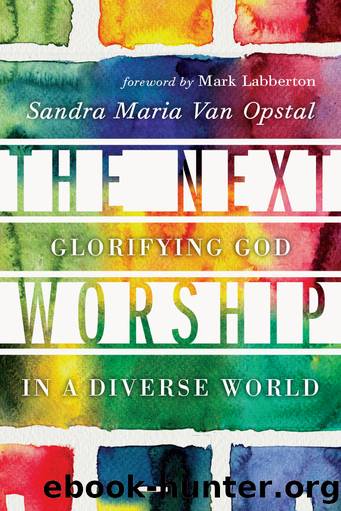The Next Worship: Glorifying God in a Diverse World by Sandra Maria Van Opstal

Author:Sandra Maria Van Opstal [Van Opstal, Sandra Maria]
Language: eng
Format: epub
ISBN: 9780830899487
Publisher: InterVarsity Press
Published: 2015-12-30T00:00:00+00:00
Three Guiding Principles
Regardless of which model is favored, three principles should guide a church that wants its worship to be inclusive.
Diverse music. Music is not everything. In fact, it is only part of the worship equation, but it is an important part. The arts are rooted in the experience of a community; they tell a story. They are written out of an encounter with God, his Word and oneâs personal life; they reflect a theology that has been developed. When I speak of music I am referring to three aspects: lyrics, melody and instrumentation. Multiethnic worship, at its basic level, should have diverse cultural expressions of song, dance, arts, poetry, language and instrumentation. When adopting these cultural elements into liturgical practices, though, itâs important to navigate the difference between a stereotype and an archetype. In the Inclusion Paradox Andrés Tapia states, âAn archetype is the tendency of a group of people to behave in a certain way. A stereotype is the belief that all members of a cultural group behave according to the archetype for that group.â13 Not all Latinos sing in Spanish. Not all black people like gospel. Not all white people sing hymns or play guitar. Not all hipsters play mandolin. To say these are always present is to stereotype. To say there is no consistent presence of these elements is foolish. To have diverse worship you must consider the breadth of ethnic expressions. I encourage you to access the many resources that are available regarding different worship cultures. Some books, websites and articles can be found in appendix B. Appendix I also includes summary descriptions of four major North American ethnic categories of worship.
Diverse platform. One white male once told me he attended a black church for over a year and never considered joining the choir. He confessed that not seeing white people on the platform caused him to internalize the message that he was there as an observer. Itâs shallow if people arenât invited to collaborate, and conversely powerful when people see themselves in leadership. Inclusion is not helpful if itâs mere representation, tokenism, but when space is provided to work across differences it is empowering. Tokenism pats itself on the back for having an Asian person on the worship team. Empowerment allows space for that Asian person to influence what happens on the team and on Sunday morning.
Diverse leadership. A diverse group of leaders that are culturally competent is key to multicultural worship; this type of collaborating community encourages the development of a robust theology of and approaches to worship. Such collaboration allows worship leaders to include their traditions in a way that someone from the outside canât. The depth of collaboration will depend on the model. A shared leadership model (see chap. 4) views inclusion as central to the teamâs philosophy and practice of multiethnic worship. Note, though, that the more diverse, not only racially but culturally and socioeconomically, the more the teamâs assumptions will be challenged.
The application of these three principles may vary depending on context.
Download
This site does not store any files on its server. We only index and link to content provided by other sites. Please contact the content providers to delete copyright contents if any and email us, we'll remove relevant links or contents immediately.
Joan of Arc by Mary Gordon(4000)
Victory over the Darkness by Neil T. Anderson(2803)
The Gnostic Gospels by Pagels Elaine(2459)
Devil, The by Almond Philip C(2266)
The Nativity by Geza Vermes(2165)
The Psychedelic Gospels: The Secret History of Hallucinogens in Christianity by Jerry B. Brown(2112)
Going Clear: Scientology, Hollywood, and the Prison of Belief by Lawrence Wright(1925)
Going Clear by Lawrence Wright(1910)
A TIME TO KEEP SILENCE by Patrick Leigh Fermor(1850)
Barking to the Choir by Gregory Boyle(1773)
Old Testament History by John H. Sailhamer(1757)
Augustine: Conversions to Confessions by Robin Lane Fox(1727)
A Prophet with Honor by William C. Martin(1672)
A History of the Franks by Gregory of Tours(1670)
The Bible Doesn't Say That by Dr. Joel M. Hoffman(1640)
The Knights Templar by Sean Martin(1618)
by Christianity & Islam(1585)
The Amish by Steven M. Nolt(1523)
The Source by James A. Michener(1521)
